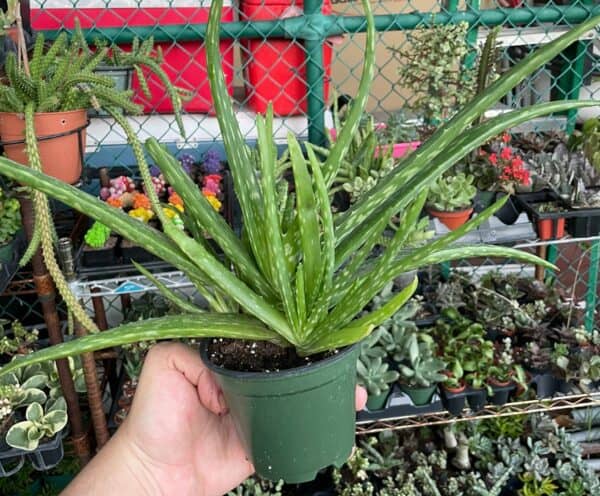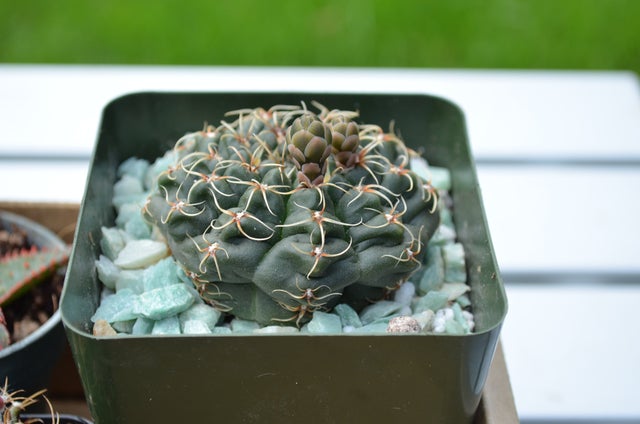I was about to order a terrarium online and it occurred to me, are terrariums even good for succulents?
In short, yes, the right terrarium is a great environment for your succulents. When layered, watered, and kept at the right temperature with moderate sun exposure, a terrarium can bring out the best in your succulent AND your space. When the right care is taken, it is an ideal ecosystem for your cacti or succulents.
Terrariums look great and can bring a room to life. They can make great looking centerpieces and strong accent pieces as well.
Not only do your plants look great in a terrarium, but the composition displayed through the glass or plastic can look cool as well. A good setup can show off your style and add a lot of personality to your work or living space.
It’s important to remember that not all terrariums are created equal. Succulents simply have different needs than say a fern or an orchid. We’ll talk a little bit about what the right terrarium looks like for your succulents and how you can start off on the right foot.
Here are 5 things to help make your terrarium a healthy ecosystem for your cacti and succulents.
Choose the right terrarium
Not all terrariums are good for your succulents, or for your enjoyment of them. Your succulents are going to want a lot of airflow. Condensation is the enemy.For this reason, open-top terrariums are ideal…
…most of the time.
If you want a terrarium with a top to host your succulent garden, you will want air holes.
I like this terrarium from Syndicate Home & Garden. You can check it out on Amazon here.
Succulent choice
Not too small, not too tall, and not too wide. You don’t want your succulent outgrowing its terrarium space.

Image via pixabay.com
The right fit is essential to your plant living a long, happy, productive life. If the leaves of your succulent are overflowing, consider putting in a smaller plant or pruning a larger one.
Terrariums are the perfect place to propagate new succulents, so just know that you have options and don’t try to force a bad fit.
It’s a good idea to keep Hardy succulents with other Hardy succulents and soft succulents with other soft succulents. This way, you’re assured that all plants in the terrarium are getting what they need. You don’t want them competing for resources. One of your babies may end up losing, and when they lose you lose.

Make sure it is getting good air flow.
I really can’t stress this one enough. They do not do well with humidity.
Like I said above, if you chose a closed-top terrarium, air holes are essential, so make sure they work, and your succulent plant is getting enough air. An easy way to tell it’s a look and see if condensation is forming on the inside of the glass.
If it is, remove the top and wipe it out. blow through one of the air holes (there should be two at least), put your hand inside the glass and see if you can feel your breath.
If you can’t, try to clear the holes out with a toothpick or Q-tip. Put the glass back on the terrarium and keep an eye on it for a couple days. If condensation is still forming, try moving it out of direct sunlight.
If condensation is still forming on the inside of the glass, it may be time to consider a different enclosed system or an open top terrarium.
Your succulent is not going to be able to take too much humidity, so be mindful of condensation!
What to do about drainage
It’s super simple to find layering tutorials online. Most terrarium tutorials will follow a system like this:

Image via homeguides.sfgate.com
- Activated charcoal acts as the bottom layer. this is to help with drainage, keep the terrarium smelling clean and healthy, and act as the last stop for excess water. This layer helps prevent root rot which will kill your plant if it festers long enough.
- The next layer up from the bottom is usually some sort of gravel or coarse stone. this helps excess water drain from the top layers on down to the bottom, preventing your plant roots from hanging out in standing water.
- Moss is frequently put on the third level up to help draw moisture out of the top layers. it also looks neat as a contrasting color to the gravel below and the potting soil above.
- a good potting soil is usually at the top layer. Specialized succulent and cacti soil is highly recommended here. The specialized soil usually contains some sort of pumice to allow water to drain more quickly.
I came across a fantastic tutorial of the other day on YouTube that you can watch below. The channels called Garden answer and they have a lot of solid tutorials if you want to check them out here.
Laura went into very brief detail as to why she doesn’t subscribe to the traditional layering models. She explains, albeit briefly, that in her terrarium she’s noticed that the soil acts more like a sponge, completely negating the first two layers I described above.
What she recommended is that soil be mounted from the bottom up and to add stones or gravel on the exterior, giving the illusion of a traditional terrarium foundation.
In the tutorial, she uses a new product called Hydro Stones. Although I haven’t tried them myself, the concept is very intriguing. You can see for yourself in the video below.
Plant Maintenance is important
Exposure to light and water will make or break the experience your succulent has with its mini ecosystem. Here are the basics for caring for your succulent in a terrarium.
Terrarium + Sunlight
Keep it out of constant direct sunlight, especially if it’s in an enclosed terrarium. The lights going to hit the glass or plastic and drastically heat up the interior of the terrarium. Although succulents are sturdy creatures, they’re not all great at withstanding temperatures over 90 degrees for hours on end. they need shade.
Sunshine is important, so if you can arrange for them to get morning sunlight for a couple hours a day that is ideal.
The sun’s rays are not at their peak during this time of the day so it’s an ideal time for your succulent to soak up some of that exposure. Any longer than a couple hours a day in an enclosed terrarium, you’re asking for trouble.
If it’s an open top terrarium, it’s still important to provide a little bit of shade but you don’t have to be nearly as mindful as you do with a fully enclosed terrarium.
Terrarium + Watering
We all love succulents because you don’t have to water them too much. This is especially true in a terrarium ( have I mentioned yet that condensation is the enemy?).
At most you’re going to want to water your terrarium once a week.
It’s Perfect to upcycle an old olive oil bottle, put a bartending pour spout on it, and put a slight drizzle on the top layer.
This will help prevent over-watering and keep your succulent healthy and happy for years to come!
That’s the ins and outs of terrarium care for succulents. Just to quickly recap:
- Keep it out of direct sunlight for extended periods of time
- It’s better to underwater than over water
- Make sure there’s airflow if you want a terrarium with a top on it
- Make sure your terrarium has good drainage. Water drainage equals happy plants.
- Keep hardy with hardy and soft with soft if you’re a beginner. Feel free to explore later once you’re a little more experience to know what to look for.

This hardy succulent is in an open pot, perfect to avoid condensation and layered well to disperse the H20. It’s appropriately sized for its container and is not mixed with too many competing plants. Cacti are great to have in a terrarium!
Thank you for reading this article! Please help us out by sharing this with a friend on social media if you found it helpful.
